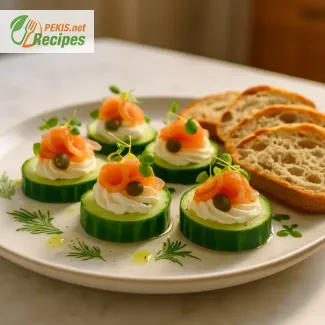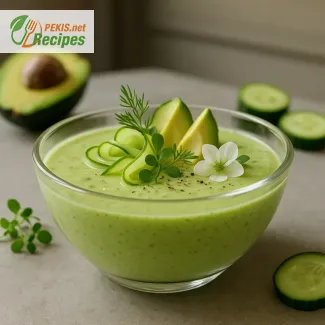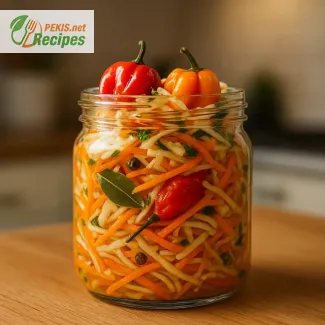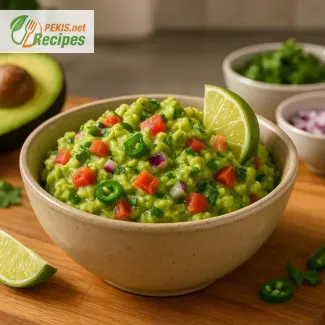
Refined starters to awaken your appetite
Elegant and simple ways to begin a memorable meal
There is something undeniably satisfying about beginning a meal with a light appetizer that teases the taste buds without overwhelming the senses. Before the rich depth of a hearty main course makes its entrance, an appetizer serves as the perfect introduction, offering subtle complexity and harmonious flavors that set the stage for what’s to come. The ideal starter should balance delicacy with flavor, offering just enough richness to excite the palate, while remaining refreshing, seasonal, and often vibrantly colorful.
In many culinary traditions around the world, the appetizer is more than just a first course—it’s a thoughtful experience. From the elegant amuse-bouches of French cuisine to the mezze platters of the Mediterranean and the fresh, crisp bites of Asian starters, these small dishes are crafted to invite curiosity and conversation at the table. Whether served at a formal dinner party, a casual family gathering, or a romantic evening for two, a light appetizer has the power to elevate the entire meal.
The key to a successful appetizer lies in its ability to entice without overpowering. Ingredients should be fresh and seasonal, with textures and temperatures designed to stimulate appetite. Think crisp vegetables, silky spreads, creamy cheeses, or lightly cured fish paired with bright herbs and tangy vinaigrettes. Simple elements, when combined with intention and precision, can create dishes that are both beautiful and satisfying.
The art of contrast and balance
When preparing a light appetizer, consider contrasts in texture, flavor, and color. A creamy element like whipped ricotta or goat cheese mousse pairs beautifully with crunchy toasted bread or raw vegetables. Tart accents such as pickled onions, lemon zest, or a drizzle of balsamic reduction can cut through richer components, enhancing the overall complexity of the dish. Color also plays an essential role in making the appetizer visually enticing—deep greens from herbs, ruby reds from tomatoes or pomegranate seeds, and golden hues from olive oil or roasted nuts create a plate that’s as stunning to look at as it is to eat.
Temperature is another important factor. A cool, crisp salad or a lightly chilled soup can be incredibly refreshing, especially in warmer months. Meanwhile, a warm tartlet, savory soufflé, or baked phyllo bite brings comfort during colder seasons. The seasonality of ingredients often dictates the direction of the dish, with spring and summer favoring lighter, raw or blanched preparations and fall and winter inviting slightly warmer and heartier but still small and refined bites.
Ingredients that shine in small portions
A well-executed appetizer highlights the natural beauty of each ingredient. In a dish where portion sizes are small, quality is paramount. Using artisan cheeses, heirloom vegetables, locally cured meats, or fresh seafood elevates even the simplest preparation. Herbs like basil, chervil, tarragon, and dill add nuanced aromas, while citrus juices, zests, and vinaigrettes bring brightness and lift.
Some of the most loved appetizers include a combination of acid, salt, and fat, all balanced with freshness. Consider a dish like smoked salmon on cucumber rounds, where the richness of the fish is balanced with the crunch of the vegetable and the zing of a touch of lemon crème fraîche. Or roasted beet carpaccio with crumbled feta, where the sweetness of the root vegetable is grounded by the salty tang of the cheese.
Designed for sharing and conversation
Light appetizers aren’t just about flavor—they also foster connection and sharing. Passed around on a tray or arranged artfully on a platter, they encourage diners to interact and engage. Whether it’s mini crostini topped with tapenade, stuffed cherry tomatoes, or tiny savory galettes, finger-friendly foods with elegant presentation make any occasion feel special.
Even in more intimate settings, such starters invite a moment of pause and enjoyment before the main course. They allow the host to showcase creativity, attention to detail, and a sense of hospitality, offering a curated experience before the central act of the meal.
Setting the tone for what's to come
Choosing the right appetizer is also a culinary statement. It reflects the tone of the meal and the intention behind it. A carefully selected starter can build anticipation, create contrast with the main dish, or even echo its flavors in a more subtle way. For example, if your main course features robust and comforting flavors, a citrusy ceviche or light tomato gazpacho can offer a refreshing counterpoint. If the main dish leans toward the delicate and refined, perhaps a savory tartlet with caramelized onions and thyme will mirror its elegance.
Ultimately, a light appetizer should be a celebration of restraint, flavor, and aesthetics. It’s not about filling up—it’s about making a memorable first impression, setting a sophisticated tone, and creating an experience that feels cohesive from the very first bite.
In the next step, we’ll explore a beautifully balanced recipe for one such appetizer—light, flavorful, and easy to prepare—perfect for enhancing your next dinner gathering.
- Prepare the cucumbers: Wash the cucumber thoroughly. Slice it into 1 cm (½ inch) thick rounds. Arrange them on a serving tray or large plate.
- Make the filling: In a bowl, mix the cream cheese, finely chopped dill, lemon juice, salt, and pepper until smooth and well blended.
- Assemble the appetizer: Place a dollop (about 1 tsp) of the cream cheese mixture on each cucumber slice.
- Add salmon: Cut the smoked salmon into small strips and curl or fold them decoratively on top of the cream cheese.
- Garnish: Add 1–2 capers on each cucumber bite and lightly drizzle with olive oil.
- Toast the bread: Slice the baguette into thin slices and lightly toast in a pan or oven until crisp. Serve on the side with a few cucumber bites placed on top.
- Finish: Garnish with microgreens for a fresh and elegant touch. Serve immediately or chill for 5–10 minutes before serving.
Elevating simple starters with refined techniques
Transforming classic appetizers into gourmet creations
Improving a traditional recipe like cucumber and smoked salmon bites might seem like a subtle art, but small enhancements can dramatically transform it into something elegant, balanced, and even healthier. By focusing on texture, ingredient quality, and complementary flavors, we can take this simple appetizer from everyday to exceptional. Whether you're cooking for a gathering or just treating yourself, knowing how to refine such recipes can create a deeper sensory experience and reflect thoughtful culinary skill.
Upgrade ingredients for deeper complexity
The most immediate and impactful improvement to any recipe comes from upgrading the ingredients. While cucumber and cream cheese are a tried-and-tested pair, there is ample room for layered flavor profiles and heightened freshness.
Replace standard cream cheese with herb-infused goat cheese or a whipped feta spread, which offers more tang and a silkier texture. Adding a touch of lemon zest or roasted garlic into the spread enhances its aroma and provides a delightful contrast to the smoky richness of the salmon. For a plant-based variation, a cashew-based vegan cream with fresh chives and lemon gives an equally luxurious mouthfeel.
Choosing wild-caught smoked salmon with a milder saltiness and more nuanced smokiness greatly improves the balance of the dish. Avoid overly salty or heavily smoked varieties, as they can overpower the other ingredients. Opt for hand-sliced pieces that can be gently folded into delicate rosettes for aesthetic appeal.
Even something as simple as the cucumber can be upgraded—English cucumbers have thinner skin and fewer seeds, offering a more refined crunch and look better when sliced. Peeling alternating stripes of the skin before slicing can create a visually appealing pattern that elevates presentation without much effort.
Add contrast with toppings and finishes
While the traditional recipe is beautifully simple, consider adding micro-ingredients to boost its overall complexity. A tiny spoonful of caviar adds elegance and a satisfying burst of salinity. A drizzle of truffle oil or a drop of yuzu juice can introduce unexpected high notes that awaken the palate.
Instead of basic capers, use pickled mustard seeds or preserved lemon peel for a touch of acidity and subtle bitterness. These additions enhance the richness of the salmon and provide that crucial balance which prevents the dish from tasting one-dimensional.
For crunch, top the finished canapé with crushed pistachios or toasted sesame seeds, offering not only a pleasant texture but also a nutty aroma that pairs surprisingly well with both the salmon and cheese components.
Why homemade is always better
A homemade appetizer like this one shines due to control over quality and personalization. Store-bought variations often use preservatives and lower-grade smoked fish, leading to a rubbery texture and excessive salt. Preparing this dish at home allows for real-time assembly, which means the cucumber stays crisp, and the cream cheese remains fresh and aerated.
Furthermore, homemade versions offer flexibility: adjusting seasoning, controlling portion size, and tailoring ingredients to dietary needs or flavor preferences. Guests appreciate the thoughtful effort behind such small bites, especially when they taste freshly made and visually appealing.
Avoid these common mistakes
Despite its simplicity, this appetizer has its pitfalls. One of the most frequent issues is soggy cucumber bases. This can be avoided by salting and patting dry the slices before assembling, which removes excess moisture. Another common mistake is applying the cream cheese too early—it can cause the cucumber to lose its crunch over time. Assemble this dish as close to serving time as possible for best results.
Another error is over-seasoning the cheese mixture, particularly with salt. Since the smoked salmon and any pickled garnish already contribute salinity, it’s best to keep the cheese mixture mildly seasoned and let the toppings provide balance.
Also, be cautious with garnishes like herbs or microgreens—using too much dill or overly wet herbs can mask delicate flavors or make the bites visually messy. Keep garnishes light, dry, and precisely placed.
Healthier and dietary-friendly alternatives
To make the dish more suitable for a wider range of diets, consider these healthy swaps:
- Replace cream cheese with whipped avocado spread for a dairy-free version rich in heart-healthy fats.
- Use grilled zucchini slices instead of cucumber for a more savory, smoky base.
- Swap smoked salmon with beet-cured trout or marinated tofu slivers for a vegetarian or pescatarian-friendly choice.
- Serve on gluten-free seed crackers instead of bread to accommodate gluten sensitivities.
Reducing the fat content can be achieved by using light cream cheese or yogurt-based spreads, while enhancing fiber with additions like chia seed dusting or a small side of raw vegetable sticks.
Serving tips for maximum impact
Presentation can completely change the way a dish is perceived. Instead of laying out cucumber bites in rows, consider placing them on a natural wood serving board or slate platter for contrast. Add a few edible flowers, like viola or nasturtium, for a splash of color.
If serving at an event, assemble a few test bites in advance and refrigerate to see how long they hold their shape and texture. For events lasting more than an hour, keep the canapés chilled until the last minute to avoid wilting or drying out.
To pair with drinks, this dish goes beautifully with dry sparkling wines, gin and tonic with citrus notes, or a cucumber-infused soda water for a non-alcoholic option. The crispness of the cucumber and richness of the salmon are enhanced by bubbly, herbal, or acidic beverages.
Customizing a classic
This cucumber and smoked salmon appetizer may start as a simple traditional recipe, but with a few smart changes, it can become an elevated, memorable bite suitable for even the most refined menus. By focusing on ingredient quality, balance of flavors, and thoughtful presentation, you can make this dish your own while respecting its refreshing origins. Whether you're adjusting for dietary needs, adding gourmet touches, or simply trying something new, small innovations can turn an everyday appetizer into a signature favorite.
Allergens present:
- Milk (cream cheese)
- Fish (smoked salmon)
- Gluten (whole grain baguette)
Tips for allergen replacement:
- Milk-free alternative: Replace cream cheese with a dairy-free plant-based spread (e.g., cashew cream cheese).
- Fish-free alternative: Use grilled marinated zucchini ribbons or sun-dried tomatoes for a vegetarian version.
- Gluten-free alternative: Substitute whole grain baguette with gluten-free bread or crackers.
- Vitamin A: 290 µg – supports immune function and vision.
- Vitamin C: 8 mg – boosts immune system and helps with collagen production.
- Vitamin D: 2 µg – contributes to bone health and calcium absorption.
- Vitamin B12: 1.1 µg – important for red blood cell formation and neurological function.
- Calcium: 60 mg – essential for healthy bones and teeth.
- Iron: 1 mg – helps transport oxygen in the blood.
- Magnesium: 25 mg – supports muscle and nerve function.
- Potassium: 260 mg – maintains healthy blood pressure and fluid balance.
- Beta-carotene: 400 µg – helps neutralize free radicals and protects skin health.
- Lutein + Zeaxanthin: 250 µg – supports eye health and reduces oxidative stress.
- Vitamin E: 1.5 mg – contributes to protection of cells from oxidative damage.
- Flavonoids (from dill and capers): 20 mg – reduce inflammation and support cardiovascular health.





